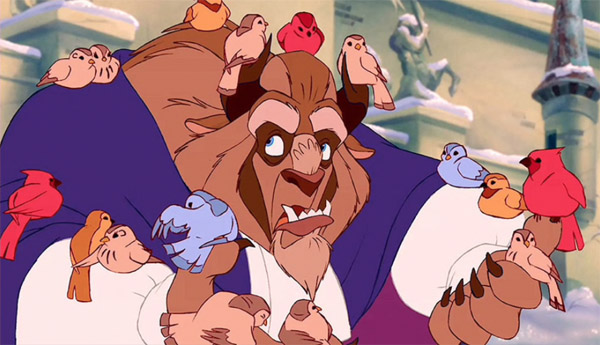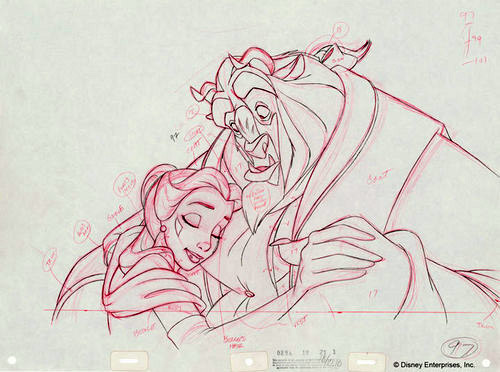
On February 19, 1992, the hope, tenacity, and determination of an entire generation of Disney artists came to a glorious finale. It was on that date that Beauty and the Beast found itself nominated for the Best Picture Oscar. It was the first animated feature to receive this recognition. The moment was a culmination of how the Disney studio had re-emerged from almost twenty years of disappointments, finding itself in an animation renaissance that would last through the decade.
Hard to believe, but this month marks the 30th anniversary of Disney’s Beauty and the Beast, an animated feature that has inspired generations of filmmakers and enchanted generations of audiences.
The idea to bring Beauty and the Beast to the screen first surfaced at Disney as far back as the 1930s, after Walt and his artists had finished work on 1937’s Snow White and the Seven Dwarfs.
It was never produced but resurfaced again at Disney, in the late ’80s, with Jill and Richard Purdum, a husband-and-wife team that owned a commercial animation studio in London, as directors. The focus was going to be a non-musical, somber version. During production, it was determined that this wasn’t working, and the film was taken in a new direction. The story was then given to screenwriter Linda Woolverton.

Woolverton infused the main character of Belle with a strong spirit and a love of reading, which changed the dynamic of the film. The Purdums soon exited the project with Gary Trousdale and Kirk Wise (who had been at Disney since the late ‘80s, working as animators on a number of films) coming on the project as co-directors. With them was Don Hahn, as producer, who had been at Disney since 1976. He had worked in a number of roles, such as associate producer and production manager on several Disney animated films in the ’70s and ’80s.
With their creative guidance, Beauty and the Beast told the “tale as old as time” of a prince, cursed by an enchantress to live out his days as a Beast (voiced by Robby Benson) and the independent Belle (Paige O’ Hara) from the nearby village.
The narcissistic Gaston (Richard White) wants Belle as his wife, but Belle wants “adventure in the great wide somewhere,” outside of her “quiet village.”
Ironically, this is precisely what she gets when she becomes confined in the Beast’s castle. Belle agrees to stay there, in exchange for her father, Maurice (Rex Everhart), who has already been captured by the Beast, being set free. While in the castle, Belle meets the “enchanted objects,” one-time servants who are also affected by the curse and are transformed themselves. There’s Lumiere the candlestick (Jerry Orbach), Cogsworth the clock (David Ogden Stiers), Mrs. Potts the teapot (Angela Lansbury), and Chip the teacup (Bradley Pearce). They see Belle as the one to help the Beast find true love and break the curse.

The enchanted objects were the brainchild of lyricist Howard Ashman, who saw them as a way to enliven the film’s second act and bring an extra element of humor and magic to the proceedings. The objects also sing the iconic and infectious showstopper, “Be Our Guest,” one of the now-legendary songs Ashman and his songwriting partner Alan Menken created for the film.
Originally, the song was to be sung to Maurice, earlier in the film, but during production, the decision was made to place “Be Our Guest” later in the film, with the enchanted objects performing for Belle.
The other songs include the rousing, opening number “Belle” and the lovely ballad “Beauty and the Beast,” both of which received Oscar nominations for Best Original Song, along with “Be Our Guest.” “Beauty and the Beast” would wind up taking home the Oscar and serve as a fitting posthumous testament to Ashman’s work on the film.
Sadly, Ashman passed away in March of 1991 from complications due to AIDS and was never able to experience how much the world would embrace Beauty and the Beast. The filmmakers lovingly dedicated the movie to him.
The music in Beauty and the Beast (much like Ashman and Menken’s work in 1989’s The Little Mermaid) once again showed how the Broadway musical had found a new home in animation. So much so that in 1994, Disney would debut Beauty and the Beast, The Broadway Musical, opening a new area of the company and a future slate of successful Broadway endeavors.

The music, blending seamlessly with the story in Beauty and the Beast, was brought to life through animators emerging as legends in the industry. Among them: Glen Keane, who brought the Beast’s internal struggle to life through stunning subtlety, James Baxter, who allowed Belle’s personality to be defined in her earliest scenes and then shift as she discovers the heart inside the Beast, and Andreas Deja (quite adept at bringing villains to life) who shone a light on Gaston’s vanity that was eerily real.
In an unprecedented move, Beauty and the Beast had its debut with a “work-in-progress” format at the New York Film Festival in September of 1991, before debuting in theaters on November 22, 1991. The reaction was unanimously glowing. Roger Ebert raved: “Beauty and the Beast reaches back to an older and healthier Hollywood tradition in which the best writers, musicians, and filmmakers are gathered for a project on the assumption that a family audience deserves great entertainment, too.”
Audiences echoed this praise, helping Beauty and the Beast to reach $331 million worldwide during its initial release. The characters fit nicely alongside the rest of the Disney canon in everything from merchandise to theme park attractions, shows, and parades.
Not only did the film have renewed and continuous life through the years thanks to Broadway, but also to a 2002 re-issue in Imax theaters (with a deleted song, “Human Again,” now included), and a very successful live-action remake in 2017.
After the release of Beauty and the Beast in 1991, the successes at the Disney studio soared on through the Renaissance period that included Aladdin (1992) and The Lion King (1994). Beauty and the Beast remains as beloved today by multiple generations as when it first debuted thirty years ago.
The milestone of the Best Picture Oscar only confirms what so many already know, Disney’s animated classic Beauty and the Beast truly is pure gold.


 Michael Lyons is a freelance writer, specializing in film, television, and pop culture. He is the author of the book, Drawn to Greatness: Disney’s Animation Renaissance, which chronicles the amazing growth at the Disney animation studio in the 1990s. In addition to Animation Scoop and Cartoon Research, he has contributed to Remind Magazine, Cinefantastique, Animation World Network and Disney Magazine. He also writes a blog, Screen Saver: A Retro Review of TV Shows and Movies of Yesteryear and his interviews with a number of animation legends have been featured in several volumes of the books, Walt’s People. You can visit Michael’s web site Words From Lyons at:
Michael Lyons is a freelance writer, specializing in film, television, and pop culture. He is the author of the book, Drawn to Greatness: Disney’s Animation Renaissance, which chronicles the amazing growth at the Disney animation studio in the 1990s. In addition to Animation Scoop and Cartoon Research, he has contributed to Remind Magazine, Cinefantastique, Animation World Network and Disney Magazine. He also writes a blog, Screen Saver: A Retro Review of TV Shows and Movies of Yesteryear and his interviews with a number of animation legends have been featured in several volumes of the books, Walt’s People. You can visit Michael’s web site Words From Lyons at: 






















The “work in progress” version is the most exhilarating. A little more than a decade after the film’s release, most of the artists who worked on it (including Yours Truly’s spouse) were thrown out without so much as a severance package. That’s why I hate computer animation, which has no soul anyway. And the stage version is a piece of junk. I don’t care that the original Broadway production ran twice as long as the original Broadway production of “My Fair Lady”; that doesn’t exactly make it twice as good.
1. I would disagree about computer animation having no soul (more like a slightly different type of soul) although, it would be nice if we get a traditional animation project again (and I feel like light might be at the end of the tunnel real soon). 2. I thought the musical was fine and there’s news of being improved hopefully by Linda herself.
Beauty and the beast the musical had to transfer theaters half way of the run, to allow another production of the little mermaid to start. There is a reason this musical is still around in amateur and professional productions. The idea of the show started when Ben Brantley stated the potential of the musical in his review.
The world lost a rare talent when Howard Ashman passed away. One can only speculate as to how Disney animation might have developed if he had lived long enough to guide it into this century. “Treasure Planet” as a musical romance? Why not? If anyone could have made it work, it was Ashman.